
Portland Harbour is located beside the Isle of Portland, Dorset, on the south coast of England. Construction of the harbour began in 1849; when completed in 1872, its 520-hectare (1,300-acre) surface area made it the largest human-made harbour in the world, and it remains one of the largest in the world today. It is naturally sheltered by Portland to the south, Chesil Beach to the west and mainland Dorset to the north. It consists of four breakwaters: two southern and two northern. These have a total length of 4.57 km (2.84 mi) and enclose approximately 1,000 ha of water.

The North America and West Indies Station was a formation or command of the United Kingdom's Royal Navy stationed in North American waters from 1745 to 1956, with main bases at the Imperial fortresses of Bermuda and Halifax, Nova Scotia. The North American Station was separate from the Jamaica Station until 1830 when the two combined to form the North America and West Indies Station. It was briefly abolished in 1907 before being restored in 1915. It was renamed the America and West Indies Station in 1926. It was commanded by Commanders-in-Chief whose titles changed with the changing of the formation's name, eventually by the Commander-in-Chief, America and West Indies Station.
Four ships and three shore establishments of the Royal Navy have been named HMS St Vincent:
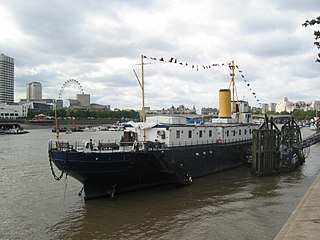
HMS President is a retired Flower-class Q-ship that was launched in 1918. She was renamed HMS President in 1922 and moored permanently on the Thames as a Royal Navy Reserve drill ship. In 1982 she was sold to private owners and, having changed hands twice, served as a venue for conferences and functions as well as the offices for a number of media companies. She has been moved to Chatham on the Medway in Kent since 2016, but is due to return to the capital. She had the suffix "(1918)" added to her name in order to distinguish her from HMS President, the Royal Naval Reserve base in St Katharine Docks. She is one of the last three surviving Royal Navy warships of the First World War. She is also the sole representative of the first type of purpose built anti-submarine vessels, and is the ancestor of World War II convoy escort sloops, which evolved into modern anti-submarine frigates.

The seventeenth Royal Navy vessel to be named HMS Dolphin was the Royal Naval shore establishment sited at Fort Blockhouse in Gosport. Dolphin was the home of the Royal Navy Submarine Service from 1904 to 1999, and location of the Royal Navy Submarine School.

HMD Bermuda was the principal base of the Royal Navy in the Western Atlantic between American independence and the Cold War. The Imperial fortress colony of Bermuda had occupied a useful position astride the homeward leg taken by many European vessels from the New World since before its settlement by England in 1609. French privateers may have used the islands as a staging place for operations against Spanish galleons in the 16th century. Bermudian privateers certainly played a role in many English and British wars following settlement, with its utility as a base for his privateers leading to the Earl of Warwick, the namesake of Warwick Parish, becoming the most important investor of the Somers Isles Company. Despite this, it was not until the loss of bases on most of the North American Atlantic seaboard threatened Britain's supremacy in the Western Atlantic that the island assumed great importance as a naval base. In 1818 the Royal Naval Dockyard, Bermuda officially replaced the Royal Naval Dockyard, Halifax, as the British headquarters for the North America Station (which would become the North America and West Indies Station after absorbing the Jamaica Station in 1830.

HMS St Christopher was a Coastal Forces training base of the Royal Navy operational during the Second World War and located in and around Fort William, Scotland.

HMS President is a "stone frigate", or shore establishment of the Royal Naval Reserve, based on the northern bank of the River Thames near Tower Bridge in Wapping and is in the London Borough of Tower Hamlets.

HMS Ganges was a training ship and later stone frigate of the Royal Navy. She was established as a boys' training establishment in 1865, and was based aboard a number of hulks before moving ashore. She was based alternately in Falmouth, Harwich and Shotley. She remained in service at RNTE Shotley until October 1976.

HMS Mercury was a shore establishment of the Royal Navy, and the site of the Royal Navy Signals School and Combined Signals School. There was also a subsidiary branch, HMS Mercury II.

HMS Imperieuse was the name given to a floating training establishment of the Royal Navy during the Second World War.
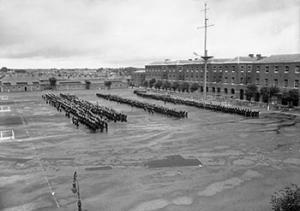
HMS St Vincent was a shore establishment of the Royal Navy, located in Gosport, Hampshire.
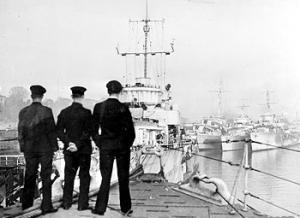
HMS Ferret was a shore establishment and naval base of the Royal Navy during the Second World War, located in Derry. It was given a ship's name as a stone frigate.
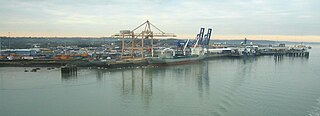
HMS Badger was a shore establishment of the Royal Navy on the east coast of the United Kingdom. She was commissioned on 13 September 1939 was the flagship of the headquarters of the Flag Officer in Charge (FOIC), Harwich who was responsible to Commander-in-Chief, The Nore, and was decommissioned on 21 October 1946, although the Operations Room remained as the Emergency Port Control for the Harwich area. The site was Parkeston Quay, now Harwich International Port, and the bunker lies under Hamilton House, currently an occupational health centre, close to the entrance to Harwich International Port, a few miles west of Harwich.
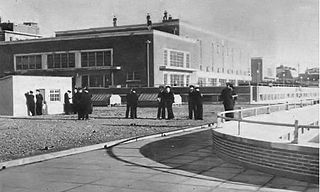
The second Royal Navy "ship" to be called HMS King Alfred was the shore establishment sited at Hove in Sussex. In 1939 on the outbreak of the Second World War, the Navy was searching for a site for a training depot for officers of the Royal Navy Volunteer Reserve (RNVR). The Sussex Division of the RNVR was based in Hove and its Motor Launch, ML 1649, was called HMS King Alfred and near to the divisional base was a new leisure centre that was just finishing construction. The Admiralty immediately requisitioned the leisure centre and on 11 September 1939 commissioned it as HMS King Alfred under the command of Captain John Pelly.

The Flag Officer Scotland and Northern Ireland (FOSNI) was a senior post in the Royal Navy of the United Kingdom. It was based at HM Naval Base Clyde, and the holder of the post was the Royal Navy’s senior officer in Scotland. The post of FOSNI, dating from 1946, was re-scoped and re-named in 1994 to Flag Officer Scotland, Northern England & Northern Ireland (FOSNNI), then named back in 2015, before being dis-established in 2020.

HMS Osprey was an anti-submarine training establishment located at the Isle of Portland, Dorset, England. It was active between 1924 and 1941, and again from 1946 to 1999. The helicopter station RNAS Portland formed part of the establishment from 1959 to 1999.
Brighlingsea Naval Base was an installation of the British Royal Navy located at Brightlingsea, Essex, on the East Coast of England. In both wars it was part of the Nore Command, which had its HQ at Chatham, and in the Second was part of Harwich Sub-Command. It existed from late 1914 to 1921, and from early 1940 to 1947,

The Red Sea Station was a military formation of the Royal Navy. At various times it has also been referred to as Egypt Division and Red Sea and later the Red Sea and Canal Area. The Royal Navy had distinct formations for the Red Sea at intervals from 1846 until circa 1944-45.
















